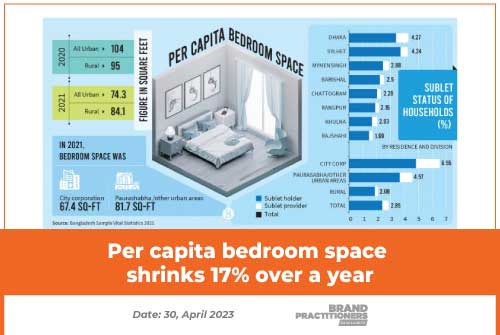Per capita bedroom floor space in the country has shrunk by 17.47% in one year, which housing experts have attributed to a mismatch between people’s income and the rising cost of living.
According to a report entitled “Bangladesh Sample Vital Statistics 2021”, released by the Bangladesh Bureau of Statistics (BBS) earlier this month, per capita bedroom size in Bangladesh dropped to 81.7 square feet in 2021 from 99 square feet a year ago.
The survey report shows that the average bedroom floor space in rural areas fell by 11.5% to 84.1 sq ft in 2021, from 95 sq ft in the previous year.
On the other hand, per capita bedroom use in urban areas declined by about 29% over the year. Its size in the cities stood at 74.3 sq ft in 2021, down from 104 sq ft in the previous year.
In previous years, however, the per capita bedroom size in urban areas was larger than that in rural areas.
According to the survey data, per capita bedroom size in the city corporation areas is the lowest at 67.4 sq ft while the average bedroom size per capita in municipal areas is 81.7 sq ft. The BBS did not disclose the size of bedrooms in cities and urban areas in its previous surveys.
Housing experts feel that many people are forced to live in smaller houses than before, as their income has not increased in line with the increase in the cost of living. Apart from that, many people are now living in subletting arrangements, causing a reduction in per capita floor space.
Rana added that people who used to live in 1,400-1,600 sq ft houses are now looking for 1,000-1,200 sq ft ones. He also mentioned that the most in-demand houses are 600-650 sq ft in floor size, which are rented for Tk10,000 to Tk11,000.
He believes that urbanization has a relationship with factors such as subletting and toilet sharing, along with the decrease in per capita floor space of bedrooms.
27.87% urban households live in own homes
According to the BBS survey, 13.16% of households in the country live in rented accommodation, while another 1.97% live in others’ houses without paying rentals. This means, 84.87% of households live in their own homes across the country.
However, the report reveals that only 27.87% of households living in city areas now live in their own homes.
The ratio of households living on rent is the highest in the city corporation area at 68.58%. Apart from this, 3.55% of households in the city live rent-free in others’ houses. Altogether, 72.13% of households live in others’ houses in city areas.
On the other hand, 94.83% of households in rural areas live in their own homes, while 3.44% of others live in rented houses and another 1.73% live rent-free in other people’s houses.
In municipalities, 30.24% of households live in rented houses and another 2.24% live in others’ houses without paying rents.
Some 64.38% of households in the Dhaka division live in their own residences, while 35.62% of others live in other people’s houses, including 1.74% rent-free lodgers.
Division-wise, a maximum of 95.12% of households live in their own homes in Mymensingh.
2.85% households live in subletting arrangement
According to the BBS survey, 2.85% of households across the country are now living in subletting arrangements.
The report says, “Subletting of dwelling houses is a common adapting strategy among the low, medium, and limited income groups which is commonly prevalent in urban areas.”
It has been seen that the number of families living in subletting arrangements is relatively very high in city corporations and municipal areas.
As against 2.08% of households in rural areas, 6.55% of households share houses in city corporation areas and the rate is 4.57% in municipalities.
Dhaka Division has the highest rate of sub-lets at 4.27%, followed by Sylhet at 4.24%. Rajshahi division has the lowest rate of sub-lets at 1.69%.
25% households share toilets
The BBS report says that 75% of households in the country have their own toilet facilities, while the remaining 25% have to share toilets.
Areas where there is a trend of renting and subletting are also more prone to toilet sharing.
A maximum of 33.1% of households in city corporation areas are forced to share toilets. The rate of toilet sharing is 24% and 25.4% respectively in rural and municipal areas.
Division-wise, the highest 31% of households share toilets in Rangpur, followed by 27.6% in Rajshahi. And, the rate of toilet sharing is the lowest in the Chattogram division at 9.8%.













